A Service-Caching Strategy Assisted by Double DQN in LEO Satellite Networks
Abstract
1. Introduction
1.1. Background and Motivations
1.2. Related Works
1.3. Contribution and Organization
- We propose a three-layer architecture integrating cloud, fog, and edge computing. The fog layer can provide services to edge users through its own content or content from neighboring nodes while also accessing content from the cloud, thereby achieving synergistic effects among cloud, fog, and edge computing.
- We utilize a reinforcement learning-based approach to train Double DQN agents and conduct simulation experiments based on synthetic data, providing an optimal solution for satellite caching schemes.
- We established a simulation experiment verification scheme and compare it with multiple methods to validate the effectiveness of the proposed approach in satellite edge caching strategies.
2. System Model
2.1. Network Model
- Fog satellite nodes: Fog satellite nodes directly connect with edge users and provide network and content services. When the requested content is available at a fog satellite node, it interacts directly with the edge user in the form of content or services. If the requested content is not pre-cached, the fog node requests it from adjacent nodes or the cloud service center and caches the relevant content.
- Adjacent satellites: If adjacent satellites cache the requested content, they collaborate to provide content or services to the satellite directly connected to the edge user and then continue to serve the edge user.
- Cloud service center: The cloud service center is connected to the backbone internet. We assume it contains all content and services. Thus, when fog nodes are unable to provide content services, they initiate content retrieval requests to the cloud center, cache the content locally, and continue to provide services.
2.2. Mobility Model
2.3. Communication Model
2.4. Caching Model
3. Implementation
3.1. Introduction to Deep Reinforcement Learning
3.2. Caching Hit Method
- Initialization: The local fog satellite selects k contents with a high request frequency as the cache content, while an adjacent satellite caches other k contents outside of the local fog satellite’s cached content.
- In each time slot, observe the current state, , calculate the Q value, and obtain the action, , taken in that state. After executing the action, observe the new state, , and obtain the reward, .
- Store the tuple as a sample in the replay buffer.
- After samples of the buffer have reached a certain number, a random batch of them is selected for training. The TD target of all contents is calculated, and the weight parameters of the evaluation network will be updated with the gradient descent method.
- After every certain number of steps, copy the weight parameters of the evaluation network to the target network.
3.3. Performance Benchmark
- Random algorithm: In this approach, the selection of content to cache on satellites is performed randomly without considering past performance or user preferences. Each piece of content is randomly assigned to a satellite for caching without any probabilistic model guiding the decision-making process. Content items are cached in no particular order, with each allocation being independent of previous cache hit outcomes or historical data.
- -greedy algorithm: In this approach, the selection of content to cache on satellites combines both the exploration and exploitation strategies. With a probability of , a random content item is chosen for caching, allowing for the exploration of new content and satellite combinations. With the remaining of the time, the algorithm exploits the known information by selecting the content with the highest estimated cache hit rate for caching on a satellite. This method balances between exploring new content possibilities and exploiting the currently known best options.
- CAFR [33]: A cooperative caching scheme for edge computing that leverages FL and DRL to predict popular content and optimize caching strategies, this approach aims to improve cache hit ratios and reduce content transmission delays. It is currently the most outstanding method in the field of edge caching.
4. Simulation
5. Conclusions
Author Contributions
Funding
Institutional Review Board Statement
Informed Consent Statement
Data Availability Statement
Acknowledgments
Conflicts of Interest
Abbreviations
| SFC | Satellite fog computing |
| Double DQN | Double Deep Q-Network |
| LEO | low Earth orbit |
| IoT | Internet of Things |
| VNI | Visual Networking Index |
| NDN | Named data networking |
| QoE | Quality of experience |
| AP | Access point |
| RL | Reinforcement learning |
| TD | Time difference |
References
- Zhang, X.; Peng, M.; Liu, C. Sensing-Assisted Beamforming and Trajectory Design for UAV-Enabled Networks. IEEE Trans. Veh. Technol. 2023, 73, 3804–3819. [Google Scholar] [CrossRef]
- Wang, Y.; Gu, L. Status quo and future development of LEO satellite mobile communication. Commun. Technol. 2020, 53, 2447–2453. [Google Scholar]
- Jia, X.; Lv, T.; He, F.; Huang, H. Collaborative data downloading by using inter-satellite links in LEO satellite networks. IEEE Trans. Wirel. Commun. 2017, 16, 1523–1532. [Google Scholar] [CrossRef]
- Li, J.; Lu, H.; Xue, K.; Zhang, Y. Temporal netgrid model-based dynamic routing in large-scale small satellite networks. IEEE Trans. Veh. Technol. 2019, 68, 6009–6021. [Google Scholar] [CrossRef]
- Sun, Y.; Peng, M.; Zhang, S.; Lin, G.; Zhang, P. Integrated satellite-terrestrial networks: Architectures, key techniques, and experimental progress. IEEE Netw. 2022, 36, 191–198. [Google Scholar] [CrossRef]
- Cisco, V. Cisco visual networking index: Forecast and trends, 2017–2022. White Pap. 2018, 1, 10–20. [Google Scholar]
- Cisco, U. Cisco Annual Internet Report (2018–2023) White Paper; Cisco: San Jose, CA, USA, 2020; Volume 10, pp. 1–35. [Google Scholar]
- Sun, Y.; Chen, S.; Wang, Z.; Mao, S. A joint learning and game-theoretic approach to multi-dimensional resource management in fog radio access networks. IEEE Trans. Veh. Technol. 2022, 72, 2550–2563. [Google Scholar] [CrossRef]
- Sellami, Y.; Jaber, G.; Lounis, A. Distributed Fog-based Caching Solution for Content-Centric Networking in IoT. In Proceedings of the 2022 IEEE 19th Annual Consumer Communications & Networking Conference (CCNC), Las Vegas, NV, USA, 8–11 January 2022; IEEE: Piscataway, NJ, USA, 2022; pp. 493–494. [Google Scholar]
- Sellami, Y.; Jaber, G.; Lounis, A.; Lakhlef, H.; Bouabdallah, A. A Cooperative Caching Scheme in Fog/Sensor Nodes for CCN. In Proceedings of the 2022 International Wireless Communications and Mobile Computing (IWCMC), Dubrovnik, Croatia, 30 May–3 June 2022; IEEE: Piscataway, NJ, USA, 2022; pp. 481–486. [Google Scholar]
- Yu, Z.; Hu, J.; Min, G.; Wang, Z.; Miao, W.; Li, S. Privacy-preserving federated deep learning for cooperative hierarchical caching in fog computing. IEEE Internet Things J. 2021, 9, 22246–22255. [Google Scholar] [CrossRef]
- Liu, S.; Hu, X.; Wang, Y.; Cui, G.; Wang, W. Distributed caching based on matching game in LEO satellite constellation networks. IEEE Commun. Lett. 2017, 22, 300–303. [Google Scholar] [CrossRef]
- Zhu, X.; Jiang, C.; Kuang, L.; Zhao, Z. Cooperative multilayer edge caching in integrated satellite-terrestrial networks. IEEE Trans. Wirel. Commun. 2021, 21, 2924–2937. [Google Scholar] [CrossRef]
- Vu, T.X.; Maturo, N.; Vuppala, S.; Chatzinotas, S.; Grotz, J.; Alagha, N. Efficient 5G edge caching over satellite. In Proceedings of the 36th International Communications Satellite Systems Conference (ICSSC 2018), Niagara Falls, ON, Canada, 15–18 October 2018; IET: London, UK, 2018; pp. 1–5. [Google Scholar]
- Zhang, H.; Xu, J.; Liu, X.; Long, K.; Leung, V.C. Joint optimization of caching placement and power allocation in virtualized satellite-terrestrial network. IEEE Trans. Wirel. Commun. 2023, 22, 7932–7943. [Google Scholar] [CrossRef]
- Xv, H.; Sun, Y.; Zhao, Y.; Peng, M.; Zhang, S. Joint beam scheduling and beamforming design for cooperative positioning in multi-beam LEO satellite networks. IEEE Trans. Veh. Technol. 2023, 73, 5276–5287. [Google Scholar] [CrossRef]
- Wang, Q.; Xu, X.; Fan, C. Distributed Resource Management for Multi-node Aggregated Satellite Edge Computing in Satellite-Terrestrial Integrated Internet of Vehicles. In Proceedings of the 2022 IEEE International Conference on Satellite Computing (Satellite), Shenzhen, China, 25–27 November 2022; IEEE: Piscataway, NJ, USA, 2022; pp. 54–55. [Google Scholar]
- Linnabary, R.B.; O’Brien, A.J.; Smith, G.E.; Ball, C.; Johnson, J.T. Using cognitive communications to increase the operational value of collaborative networks of satellites. In Proceedings of the 2019 IEEE Cognitive Communications for Aerospace Applications Workshop (CCAAW), Cleveland, OH, USA, 25–26 June 2019; IEEE: Piscataway, NJ, USA, 2019; pp. 1–6. [Google Scholar]
- Zhao, R.; Ran, Y.; Luo, J.; Chen, S. Towards coverage-aware cooperative video caching in leo satellite networks. In Proceedings of the GLOBECOM 2022–2022 IEEE Global Communications Conference, Rio de Janeiro, Brazil, 4–8 December 2022; IEEE: Piscataway, NJ, USA, 2022; pp. 1893–1898. [Google Scholar]
- Zhang, J.; Yang, Y.; Sang, H.; Gao, Z.; Song, T. Content-Aware Proportional Caching for Efficient Data Delivery over Satellite Network. In Proceedings of the GLOBECOM 2023–2023 IEEE Global Communications Conference, Kuala Lumpur, Malaysia, 4–8 December 2023; IEEE: Piscataway, NJ, USA, 2023; pp. 4890–4895. [Google Scholar]
- Zhang, T.; Wang, S.; Chen, S.; Zhang, X.; Wang, X.; He, F. Inter-satellite Cache Push Scheme Based on ICN for Low Orbit Earth Satellite Network. In Proceedings of the 2023 11th International Conference on Information Systems and Computing Technology (ISCTech), Qingdao, China, 30 July–1 August 2023; IEEE: Piscataway, NJ, USA, 2023; pp. 290–295. [Google Scholar]
- Liu, Z.; Li, Y.; Zhu, J.; Yao, Q.; Ren, X. User-Driven Cache Replacement Strategy for Satellite-Terrestrial Networks Based on SDN. In Proceedings of the 2020 IEEE 6th International Conference on Computer and Communications (ICCC), Chengdu, China, 11–14 December 2020; IEEE: Piscataway, NJ, USA, 2020; pp. 680–688. [Google Scholar]
- Wu, H.; Li, J.; Lu, H.; Hong, P. A two-layer caching model for content delivery services in satellite-terrestrial networks. In Proceedings of the 2016 IEEE Global Communications Conference (GLOBECOM), Washington, DC, USA, 4–8 December 2016; IEEE: Piscataway, NJ, USA, 2016; pp. 1–6. [Google Scholar]
- Rodríguez-Pérez, M.; Herrería-Alonso, S.; Suárez-Gonzalez, A.; López-Ardao, J.C.; Rodríguez-Rubio, R. Cache Placement in an NDN Based LEO Satellite Network Constellation. IEEE Trans. Aerosp. Electron. Syst. 2022, 59, 3579–3587. [Google Scholar] [CrossRef]
- Bommaraveni, S.; Vu, T.X.; Chatzinotas, S.; Ottersten, B. Active Popularity Learning with Cache Hit Ratio Guarantees using a Matrix Completion Committee. In Proceedings of the 2020 IEEE 31st Annual International Symposium on Personal, Indoor and Mobile Radio Communications, London, UK, 31 August–3 September 2020; IEEE: Piscataway, NJ, USA, 2020; pp. 1–5. [Google Scholar]
- Xu, Y.; Han, Y. ALIRS: A High Scalability and High Cache Hit Ratio Replacement Algorithm. In Proceedings of the 2011 International Conference on Computational and Information Sciences, Chengdu, China, 21–23 October 2011; IEEE: Piscataway, NJ, USA, 2011; pp. 66–70. [Google Scholar]
- Chen, X.; He, L.; Xu, S.; Hu, S.; Li, Q.; Liu, G. Hit ratio driven mobile edge caching scheme for video on demand services. In Proceedings of the 2019 IEEE International Conference on Multimedia and Expo (ICME), Shanghai, China, 8–12 July 2019; IEEE: Piscataway, NJ, USA, 2019; pp. 1702–1707. [Google Scholar]
- Zhong, G.; Yan, J.; Kuang, L. QoE-driven social aware caching placement for terrestrial-satellite networks. China Commun. 2018, 15, 60–72. [Google Scholar] [CrossRef]
- Han, D.; Peng, H.; Wu, H.; Liao, W.; Shen, X.S. Joint cache placement and content delivery in satellite-terrestrial integrated C-RANs. In Proceedings of the ICC 2021-IEEE International Conference on Communications, Montreal, QC, Canada, 14–23 June 2021; IEEE: Piscataway, NJ, USA, 2021; pp. 1–6. [Google Scholar]
- Zhao, R.; Luo, J.; Ran, Y. Coverage-Aware Cooperative Caching and Efficient Content Distribution Schemes in LEO Satellite Networks. In Proceedings of the 1st ACM MobiCom Workshop on Satellite Networking and Computing (SatCom ’23). Association for Computing Machinery, New York, NY, USA, 6 October 2023; pp. 31–36. [Google Scholar]
- Qiu, C.; Yao, H.; Yu, F.R.; Xu, F.; Zhao, C. Deep Q-learning aided networking, caching, and computing resources allocation in software-defined satellite-terrestrial networks. IEEE Trans. Veh. Technol. 2019, 68, 5871–5883. [Google Scholar] [CrossRef]
- Wang, R.; Kishk, M.A.; Alouini, M.S. Evaluating the Accuracy of Stochastic Geometry Based Models for LEO Satellite Networks Analysis. IEEE Commun. Lett. 2022, 26, 2440–2444. [Google Scholar] [CrossRef]
- Wu, Q.; Zhao, Y.; Fan, Q.; Fan, P.; Wang, J.; Zhang, C. Mobility-aware cooperative caching in vehicular edge computing based on asynchronous federated and deep reinforcement learning. IEEE J. Sel. Top. Signal Process. 2022, 17, 66–81. [Google Scholar] [CrossRef]
- Zhou, J.; Sun, Z.; Zhang, R.; Lin, G.; Zhang, S.; Zhao, Y. A cloud-edge collaboration CNN-based routing method for ISAC in LEO satellite networks. In Proceedings of the 2nd Workshop on Integrated Sensing and Communications for Metaverse, Helsinki, Finland, 18 June 2023; pp. 25–29. [Google Scholar]
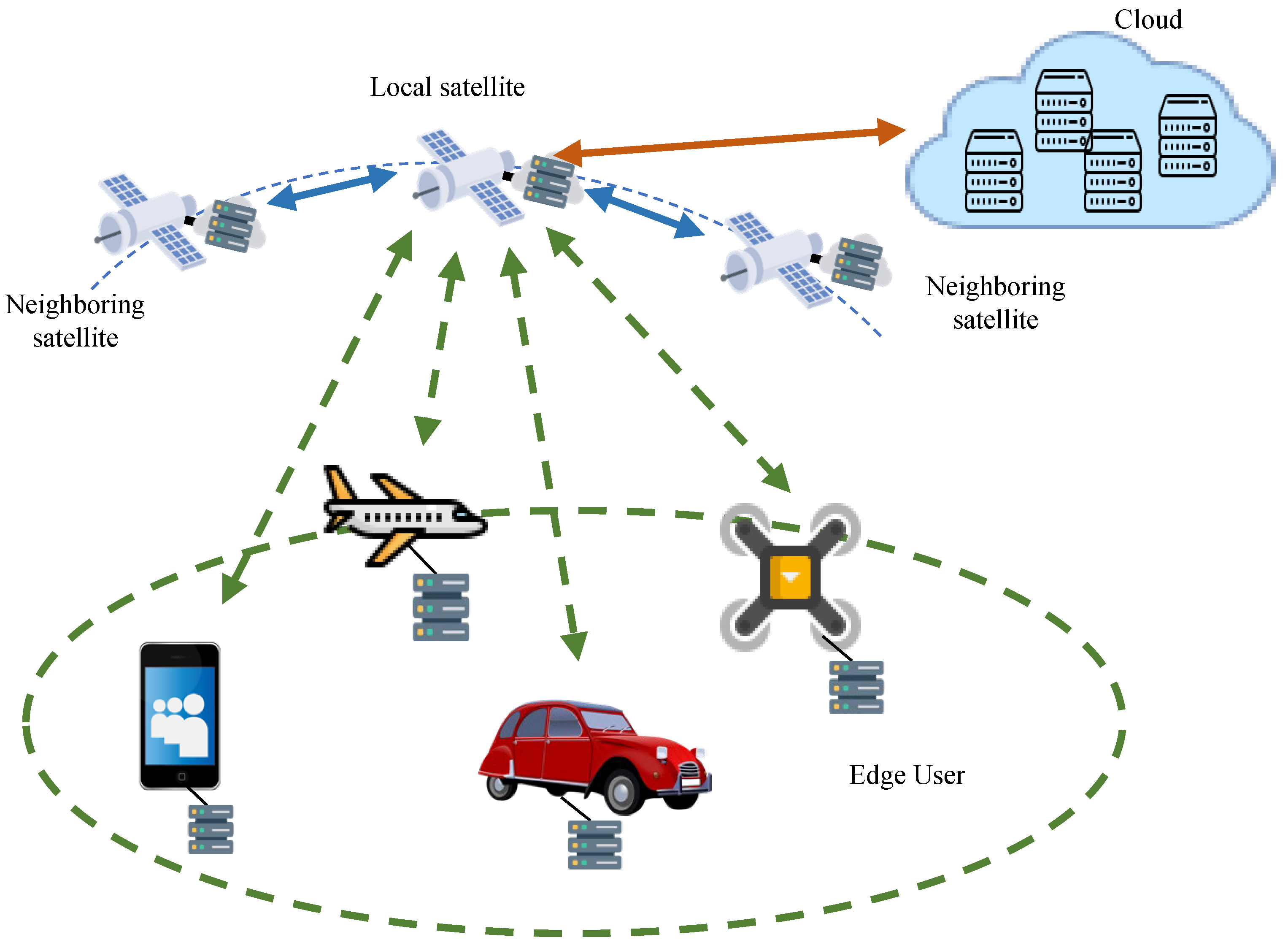
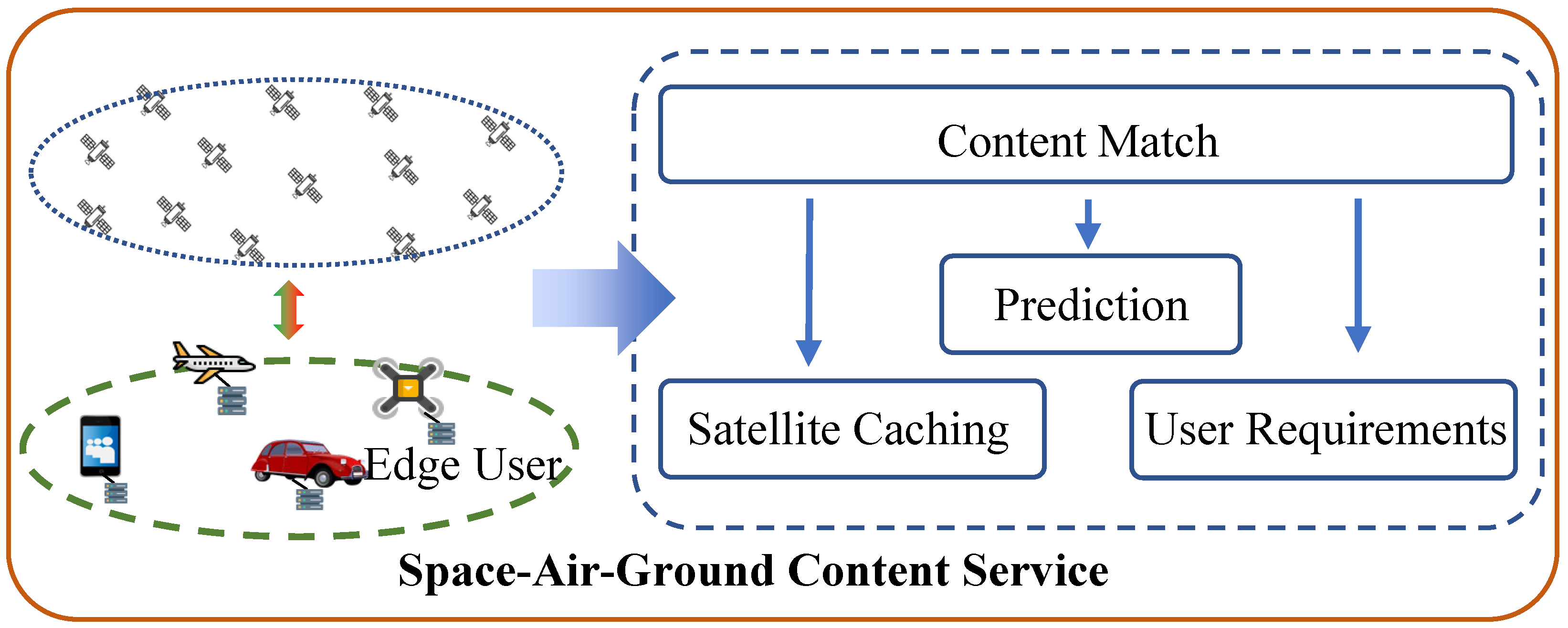
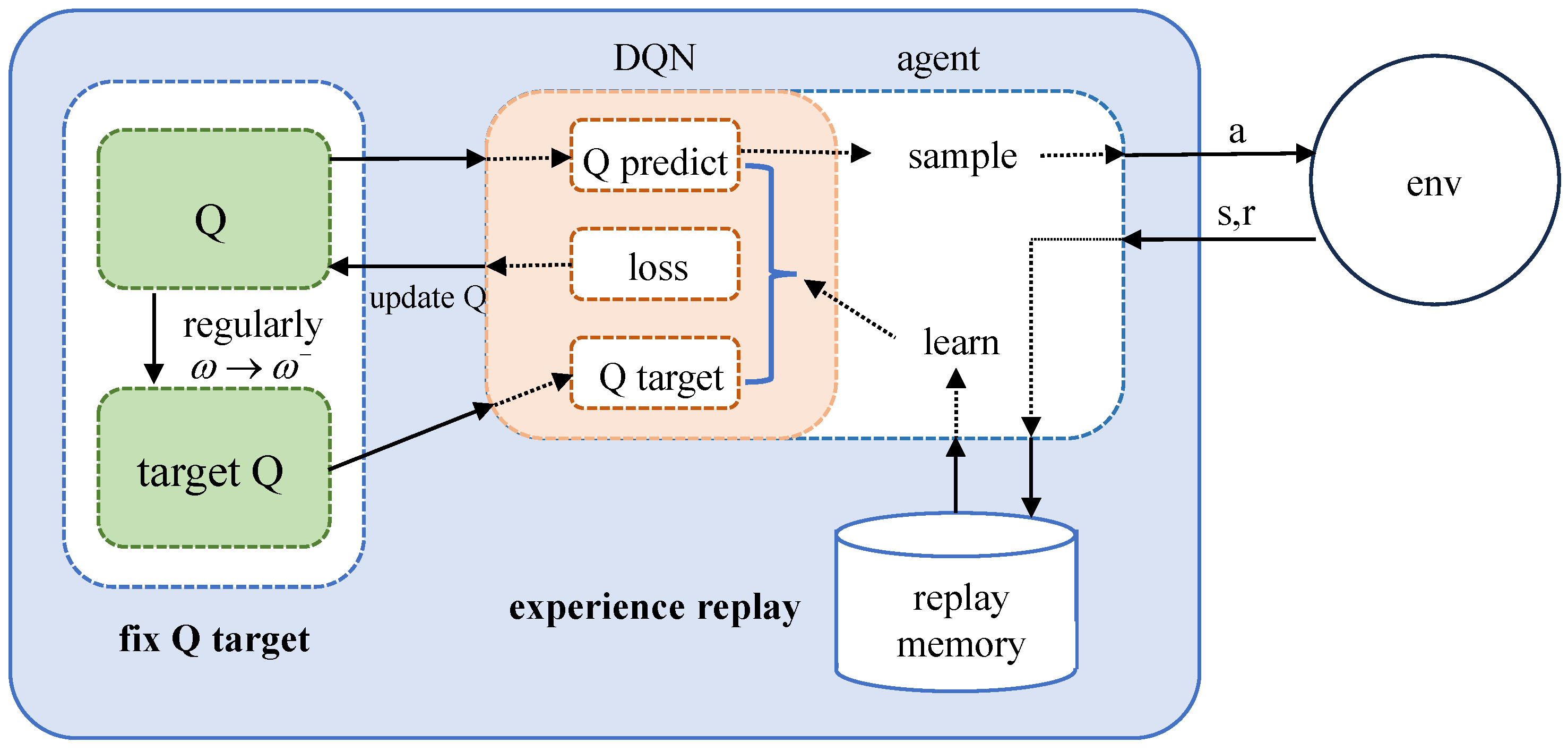

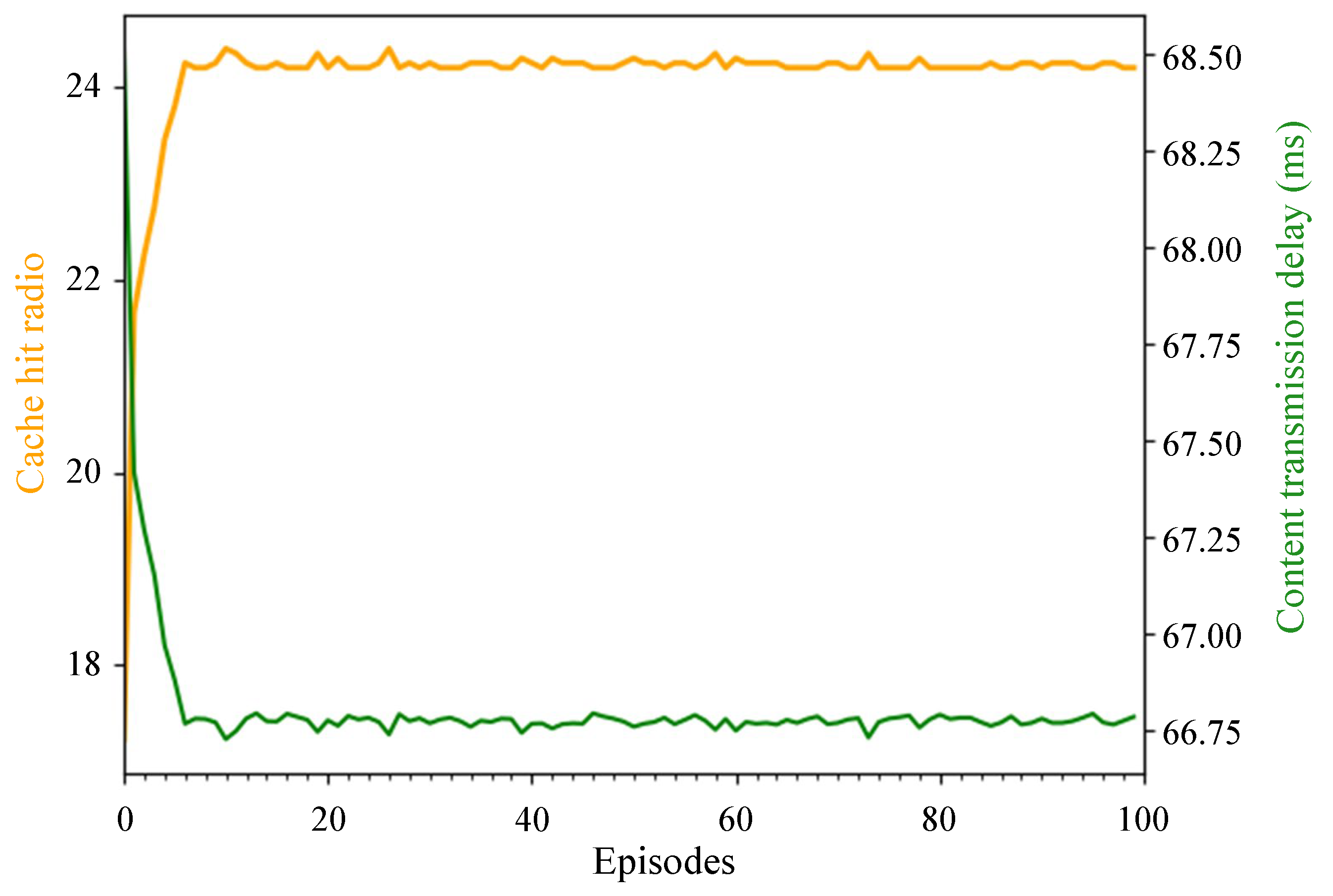
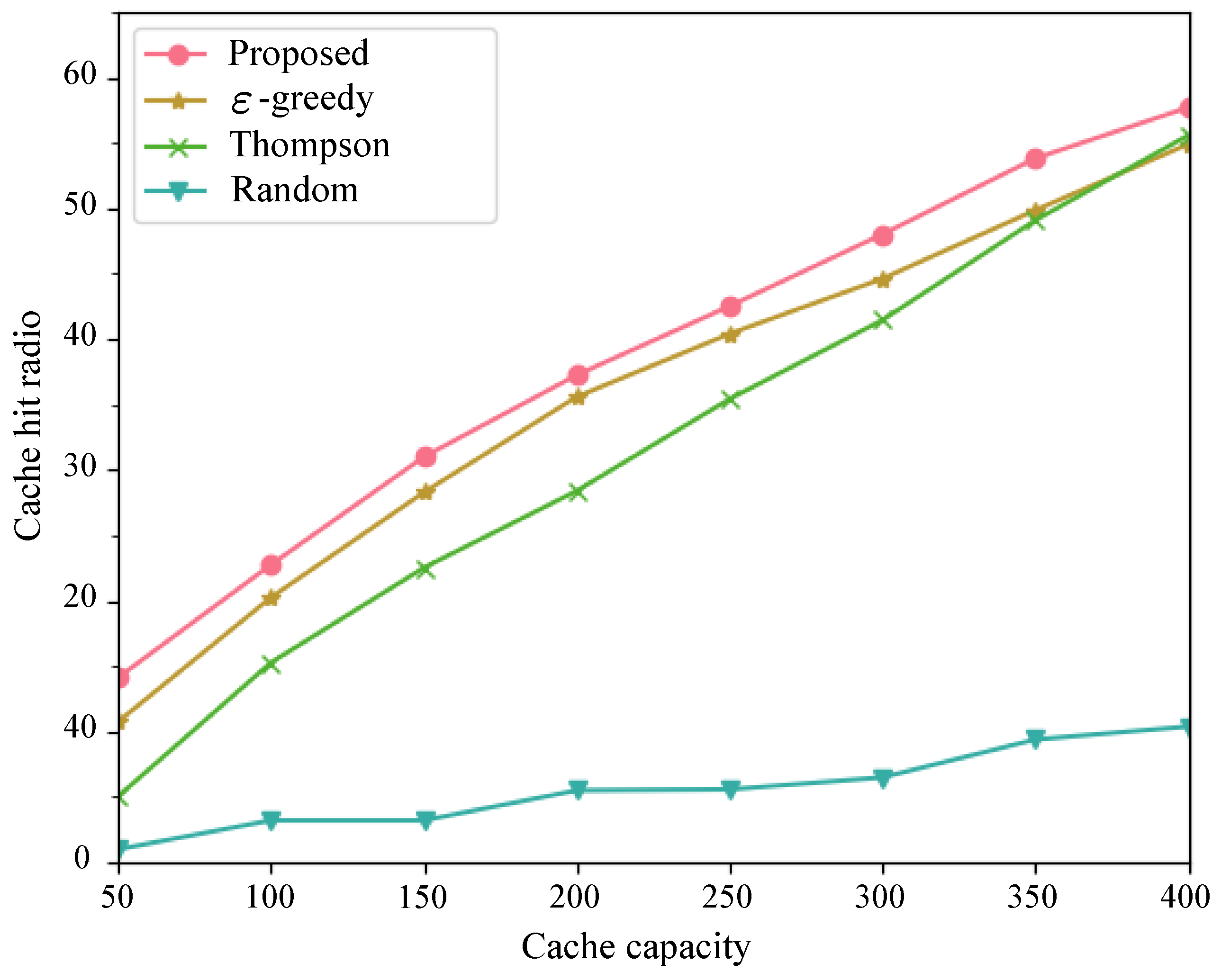


| Variable | Description |
|---|---|
| LEO satellite bandwidth | 500 MHz |
| LEO satellite altitude | 1000 km |
| LEO satellite antenna gain | 40 dBi |
| UE antenna gain | 30 dBi |
| Number of UEs | 50–400 |
| Number of Sats | 66 |
Disclaimer/Publisher’s Note: The statements, opinions and data contained in all publications are solely those of the individual author(s) and contributor(s) and not of MDPI and/or the editor(s). MDPI and/or the editor(s) disclaim responsibility for any injury to people or property resulting from any ideas, methods, instructions or products referred to in the content. |
© 2024 by the authors. Licensee MDPI, Basel, Switzerland. This article is an open access article distributed under the terms and conditions of the Creative Commons Attribution (CC BY) license (https://creativecommons.org/licenses/by/4.0/).
Share and Cite
Luan, Y.; Sun, F.; Zhou, J. A Service-Caching Strategy Assisted by Double DQN in LEO Satellite Networks. Sensors 2024, 24, 3370. https://doi.org/10.3390/s24113370
Luan Y, Sun F, Zhou J. A Service-Caching Strategy Assisted by Double DQN in LEO Satellite Networks. Sensors. 2024; 24(11):3370. https://doi.org/10.3390/s24113370
Chicago/Turabian StyleLuan, Yuchen, Fukun Sun, and Jiaen Zhou. 2024. "A Service-Caching Strategy Assisted by Double DQN in LEO Satellite Networks" Sensors 24, no. 11: 3370. https://doi.org/10.3390/s24113370
APA StyleLuan, Y., Sun, F., & Zhou, J. (2024). A Service-Caching Strategy Assisted by Double DQN in LEO Satellite Networks. Sensors, 24(11), 3370. https://doi.org/10.3390/s24113370






